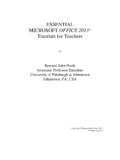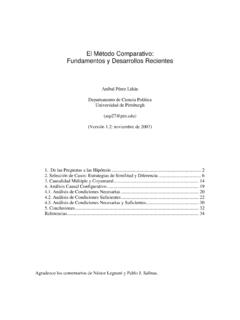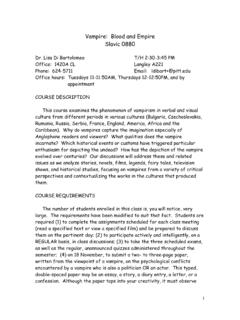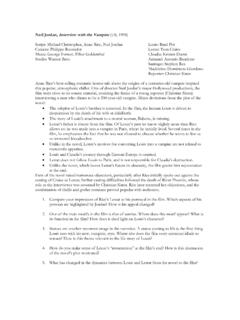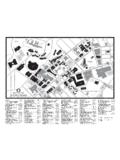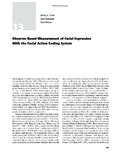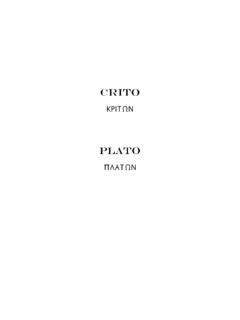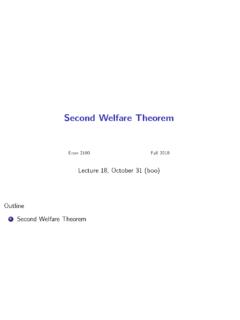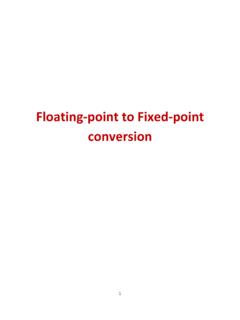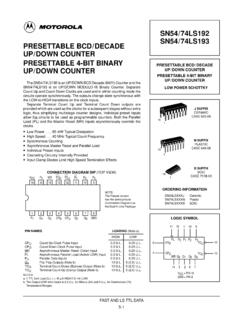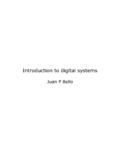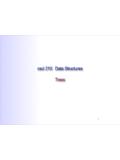Transcription of Lecture 3 Floating Point Representations
1 1 Lecture 3 Floating Point Representations ECE 0142 Computer Organization2 Floating - Point arithmetic We often incur Floating - Point programming. Floating Point greatly simplifies working with large ( , 270) and small ( , 2-17) numbers We ll focus on the IEEE 754standard for Floating - Point arithmetic. How FP numbers are represented Limitations of FP numbers FP addition and multiplication3 Floating - Point representation IEEE numbers are stored using a kind of scientific notation. mantissa *2exponent We can represent Floating - Point numbers with three binary fields: a sign bit s, an exponent field e, and a fraction field f.
2 The IEEE 754 standard defines several different precisions. Single precision numbers include an 8-bit exponent field and a 23-bit fraction, for a total of 32bits. Double precision numbers have an 11-bit exponent field and a 52-bit fraction, for a total of The sign bitis 0 for positive numbers and 1 for negative numbers. But unlike integers, IEEE values are stored in signed There are many ways to write a number in scientific notation, but there is always a uniquenormalizedrepresentation, with exactly one non-zero digit to the left of the Point .
3 103= 101= * 102= ..01001 = 23= .. What s the normalized representation of ? 25 What s the normalized representation of ? 2-4sef6 Mantissa There are many ways to write a number in scientific notation, but there is always a uniquenormalizedrepresentation, with exactly one non-zero digit to the left of the Point . 103= 101= * 102= ..01001 = 23= .. The field f contains a binary fraction. The actual mantissa of the Floating - Point value is (1 + f). In other words, there is an implicit 1 to the left of the binary Point .
4 For example, if f is , the mantissa would be A side effect is that we get a little more precision: there are 24 bits in the mantissa, but we only need to store 23 of them. But, what about value 0?sef7 Exponent There are special cases that require encodings Infinities (overflow) NAN (divide by zero) For example: Single-precision: 8 bits in e 256 codes; 11111111reserved for special cases 255 codes; one code (00000000) for zero 254 codes; need both positive and negative exponents half positives (127), and half negatives (127) Double-precision: 11 bits in e 2048 codes; reserved for special cases 2047 codes; one code for zero 2046 codes.
5 Need both positive and negative exponents half positives (1023), and half negatives (1023)sef8 Exponent The e field represents the exponent as a biasednumber. It contains the actual exponent plus 127for single precision, or the actual exponent plus 1023in double precision. This converts all single-precision exponents from -126to +127 into unsigned numbers from 1 to 254, and all double-precision exponents from -1022to +1023 into unsigned numbers from 1 to 2046. Two examples with single-precision numbers are shown below. If the exponent is 4, the e field will be 4 + 127 = 131 (100000112).
6 If e contains 01011101 (9310), the actual exponent is 93 -127 = -34. Storing a biased exponent means we can compare IEEE values as if they were signed Between e and Actual ExponenteActual Exponent0000 0000 Reserved0000 00011-127 = -126-126100000 00102-127= 1110254-127=127127101111 1111 Reserved10 Converting an IEEE 754 number to decimal The decimal value of an IEEE number is given by the formula:(1 -2s) * (1 + f) * 2e-bias Here, the s, f and e fields are assumed to be in decimal. (1 -2s) is 1 or -1, depending on whether the sign bit is 0 or 1.
7 We add an implicit 1 to the fraction field f, as mentioned earlier. Again, the bias is either 127 or 1023, for single or double IEEE-decimal conversion Let s find the decimal value of the following IEEE First convert each individual field to decimal. The sign bit s is 1. The e field contains 01111100= 12410. The mantissa is Then just plug these decimal values of s, e and f into our formula.(1 -2s) * (1 + f) * 2e-bias This gives us (1 -2) * (1 + ) * 2124-127= ( * 2-3) = a decimal number to IEEE 754 What is the single-precision representation of convert the number to binary : the number by shifting the binary Point until there is a single 1 to the x 20= x bits to the right of the binary Point comprise the fractional field number of times you shifted gives the exponent.
8 The field e should contain: exponent + bit: 0 if positive, 1 if What is the single-precision representation of 29s = 0e = 9 + 127 = 136 = 10001000f = 0011111111011 The single-precision representation is:0 10001000 0011111111011000000000014 Examples: Compare FP numbers ( <, > ? ) 0111 1111 1000 0000 + 2 (127-127) = + 2 (128-127)= 0111 1111 1000 0000 + 0111 1111 <+ 1000 0000directly comparing exponents as unsigned values gives 0111 1111 1 1000 0000 2(0111 1111 )-f 2(1000 0000)For exponents: 0111 1111 < 1000 0000So -f 2(0111 1111 )> -f 2(1000 0000)15 Special Values (single-precision) + and (-1)Sx 2-126x ( ) a Number16 EReal ExponentFValue0000 (-1)Sx 2-126x ( )0000 0001-12610 Normalized(-1)Sx 2e-127x ( )0000 1110127101111 of numbers Normalized (positive range.)
9 Negative is symmetric) Unnormalized0000000010000000000000000000 0000+2-126(1+0) = 2-12601111111011111111111111111111111+21 27(2-2-23)smallestlargestsmallestlargest 00000000000000000000000000000001+2-126(2 -23) = 2-14900000000011111111111111111111111+2- 126(1-2-23)02-1492-126(1-2-23)2-1262127( 2-2-23)Positive underflowPositive overflow18In comparison The smallest and largest possible 32-bit integersin two s complement are only -231and 231-1 How can we represent so many more values in the IEEE 754 format, even though we use the same number of bits as regular integers?
10 02-126what s the next representable FP number?+2-126(1+2-23)differ from the smallest number by 2-14919 There aren t more IEEE numbers. With 32 bits, there are 232, or about 4 billion, different bit patterns. These can represent 4 billion integers or4 billion reals. But there are an infinite number of reals, and the IEEE format can only represent someof the ones from about -2128to +2128. Represent same number of values between 2nand 2n+1as 2n+1and 2n+2 Thus, Floating - Point arithmetic has issues Small roundoff errors can accumulate with multiplications or exponentiations, resulting in big errors.
